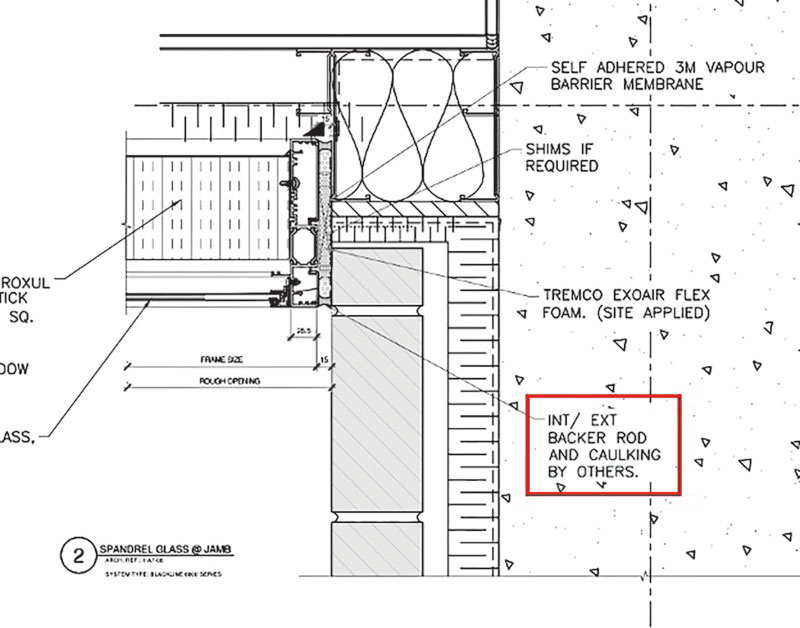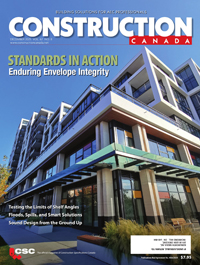By others: The legend of the ghost builder

The largest and most elusive contractor in North America is not a company with a website or office; it is the infamous “By Others.” This fictional entity has been created, acknowledged, and perpetually promoted by architects, engineers, specification writers, designers, fabricators, manufacturers, and long-standing construction practices throughout the industry.
The term “By Others” is commonly used, but its lack of a clear definition creates confusion regarding its scope. Uncertainty about who is responsible for what contributes to the problem, which is being highlighted in this article. Teams should collaborate and seek to understand the goals, objectives, and adjacent scopes of their counterparts.
After 25 years of scrutinizing construction documentation, this author has consistently witnessed how “By Others” infiltrates drawings, specifications, and contracts, silently embedding itself wherever design is weak, requirements are vague, or responsibilities are undefined.
The failure to clearly define where one scope ends and another begins, and to account for the space in between, has become a defining vulnerability in the industry.
Ironically, the true art of contract documentation lies in doing the opposite: Defining responsibilities, liabilities, deliverables, and terms of the construction relationship, and leaving nothing “By Others.”
To unpack how “By Others” persists in practice, this article is organized into the following sections: a satirical biography of the phantom contractor, the dilemma, tactics by which “By Others” enters documentation, the role of design ambiguity and professional obligations, a case study illustrating the consequences, and finally, remedies, standards, and strategies to reduce reliance on this fictional figure.

Brief biography
Credentials of the untraceable:
1. Place of origin
“By Others” has been widely cited in architectural and engineering drawings, cut sheets, construction contracts, shop drawings, RFIs, addenda, submittals, specifications, and more.
2. Experience
“By Others” brings expertise across the entire building envelope, from below-grade to structural framing to finishing details, covering virtually any type of construction work.
3. Qualifications
“By Others” appears on the most complex projects across the continent, thriving where others are disqualified for lack of expertise, manpower, or financial capacity.
4. Strength
Firmly embedded in contract documents, “By Others” is entrusted with the toughest, most undefined tasks, typically those no contractor wants or dares to claim.
5. Reliability
“By Others” is routinely called upon to supply components, perform installations, and grant approvals to proceed. However, they never actually showed up on any construction site and did not complete their assigned scope.
6. Reputation
While “By Others” is widely known in the industry, concerns persist about their chronic absence and incomplete work. A growing backlog of lawsuits appears perpetually pending, but no one can find them to serve the papers.
7. Accountability
Despite being named in thousands of documents, “By Others” has never attended a pre-bid meeting, submitted a tender, responded to a request for information (RFI), or negotiated a contract.
8. Status
“By Others” holds an unshakable recognition across the construction industry. Yet it is entirely untraceable and never accountable. Still, it persists, haunting the margins and footnotes where responsibility quietly disappears.
9. References
Provided upon request. “By Others” is trusted by a broad network of architects, engineers, builders, manufacturers, and contractors who regularly collaborate on a wide range of projects.
10. Address
“By Others” has no fixed address, office, website, or contact number. However, they permanently reside in the documents.
Notably, Canadian Construction Documents Committee (CCDC) 2–2020 makes no reference to the phrase ‘By Others.’ Its absence underscores how the term has developed informally in practice rather than through contractual definition.
The dilemma: Facing the invisible brilliant contractor
The repeated use of the term “By Others” has led to widespread confusion and misinterpretation across construction documentation and contract administration.
Some creative construction participants have even introduced an advanced version of “By Others”: “NBU,” short for “Not By Us.”
Different name, same vague terms and conditions, and the same ghost contractor still lurking in the documents.
“By Others” is more than a harmless label; it is a convenient escape hatch that shifts responsibility into a contractual void. It slips into drawings, specs, submittals, and contracts wherever ambiguity exists. It is not announced, but it is deeply felt in scope gaps, miscommunication, and costly rework.
The more ambiguous the design or documentation, the larger the territory this phantom contractor claims.
Too often, ambiguity is chosen over clarity, hoping things will somehow fall into place. However, instead of refining the design, assigning responsibility, or resolving the unknowns, vagueness prevails. And in that vacuum, “By Others” quietly takes control, unnoticed until it is too late.

Common tactics of ‘By Others’
Direct specification
Sometimes, “By Others” is explicitly introduced into contract documents by assigning responsibility to an undefined party. This appears in general notes/conditions, addenda, schedules, specifications, shop drawing comments, and more, effectively shifting responsibility without identifying who is accountable.
In shop drawings, “By Others” is often used by subcontractors to indicate that a product, material, or activity is required but not within their scope. While this may clarify what they are excluding, it still leaves open the larger question of who is responsible. Any party involved in the project should know who is doing what; when adjacent systems or scopes are not clearly co-ordinated, issues inevitably arise later in the process, creating delays, confusion, and potential disputes.
Familiar examples include:
- Proceed with work upon approval “By Others”
- Submit sample for review “By Others”
- Expansion joint “By Others”
- Electrical control switch “By Others”
- Bore data sheets “By Others”
- Anchor plates to be built-in “By Others”
This approach may seem convenient during design or procurement, but it often leads to disputes during contract administration, commissioning, or auditing.
Their name appears wherever design stops short of decision-making. It is these misalignments, where intent, responsibility, and execution fail to meet, that “By Others” finds fertile ground.
It is important to note that the architect’s professional obligations for services of contract documents are meant to convey the design intent clearly enough to allow construction, bidding, and regulatory compliance. They are not expected to provide step-by-step instructions for every activity. However, the documents must still be complete enough to enable contractors to execute the design accurately and consistently. This balance between clarity and reasonable limits is essential context for understanding how “By Others” fills the void of omitted responsibility.
Ambiguity in design
Ambiguity in design, as explored below, connects directly to these professional obligations. When responsibilities are not clearly allocated within the design team, gaps emerge in the documentation. CCDC 2-2020 reinforces that dividing work among subcontractors is the constructor’s role, not the contract documents’—which means the design team must resolve grey areas among themselves before documents are issued.
Design development is often rushed, leaving critical gaps through vague language, incomplete detailing, or omitted responsibilities. These omissions create fertile ground for ambiguity, and “By Others” fills the void. Without clearly defined scopes, responsibility quietly multiplies in the background only to surface during bidding, construction, or even occupancy, when it is far too late for seamless resolution. Incomplete design inevitably leads to a surge of RFIs from contractors seeking clarity, followed by a stream of avoidable site instructions that disrupt workflow, delay progress, and burden all parties with layers of reactive paperwork. Thorough design review and interdisciplinary co-ordination are essential to uncover these issues early before they spiral into confusion, disputes, and administrative fatigue on-site.
While it is recognized that architects and engineers are not responsible for producing construction documents that are literally exhaustive or instruction-manual precise, the scale of the problem in practice is hard to ignore. On some projects, each discipline is generating thousands of RFIs—far beyond what could reasonably be considered normal clarification. This volume of back-and-forth signals systemic gaps in design communication and co-ordination, creating significant confusion and inefficiencies for everyone involved. Addressing this requires a balanced approach: acknowledging the limits of design documentation while still strengthening review processes and interdisciplinary collaboration to reduce the reliance on “By Others” as a catch-all.
Ambiguity in design is not just about missing details; it is also about unclear boundaries of responsibility. The professional design team must establish among themselves where grey areas lie, ensuring that design documents present a co-ordinated and consistent framework. At the same time, it is important to respect that contract documents should not attempt to assign work to particular subcontractors or trades. Under CCDC 2-2020, the division of work among subcontractors and suppliers rests with the constructor, guided by trade jurisdictions and industry practice. In other words, design teams must clarify design intent and eliminate scope gaps, while constructors determine how that work is allocated in execution.

Compatibility of documents
Beyond unintentional omissions, there are systemic issues in contract document preparation. This is illustrated through two key examples:
From the specifications perspective
- Inconsistent language or terminology
- Outdated standards or formats
- Overreliance on copy-paste content/practice
- Missing project-specific details
- Loosely worded instructions that leave scope and responsibility open to interpretation
From the drawing’s perspective
- Poorly managed computer-aided design (CAD) or building information modelling (BIM) standards
- Incomplete co-ordination between specs and drawings
- Weak or absent linking between contract documents
While often associated with construction documents such as drawings and technical specifications, the influence of “By Others” runs deeper into the core of contract documentation.
The gaps are not just about missing details or vague notes; they often emerge between the documents themselves: mismatched scopes of work, conflicting specifications, misaligned general conditions and trade packages, or undefined requirements for delegated design and component selection.
It is in these misalignments where intent, responsibility, and execution fail to meet that “By Others” finds fertile ground.
The language problem: Ambiguous acronyms and phrases
Vague terms such as “By Others” do not operate alone; they often travel with equally ambiguous acronyms and phrases that compound confusion in construction documents.
Common culprits include acronyms such as To Be Determined (TBD) and NBU, and phrases such as “as required,” “if necessary,” “where applicable,” “as needed,” or “unless noted otherwise.”
These shorthand expressions may seem harmless or even helpful during early design, but when left unresolved, they evolve into contractual blind spots. They obscure accountability, postpone decision-making, and open the door for inconsistent interpretation across teams and trades. Too often, these terms survive into issued-for-construction documents, where their presence becomes a liability.
To address this persistent issue, project teams should implement two foundational practices:
- Acronym and phrase legend—Incorporate a comprehensive “legend of terms” within every specification and drawing set to clearly define all abbreviations and ambiguous phrases. This ensures consistent interpretation across all disciplines.
- Responsibility pairing—Require that every instance of TBD, NBU, or “By Others” is accompanied by:
- A clearly identified responsible party, or
- A defined resolution process with a binding deadline.
When properly documented and managed, placeholder terms can serve as temporary tools for co-ordination. However, when left undefined, they introduce ambiguity, increase risk, and often lead to scope gaps, delays, and contractual disputes.
Case study: Curtain wall anchors ‘By Others’ gone wrong
- Project—High-rise mixed-use development in downtown Toronto
- Issue—Curtain wall anchorage co-ordination failure
- Offending note—Anchorage to be provided “By Others”
Root cause analysis
Architectural documentation—Performance specifications were provided for the curtain wall system, but the slab-to-facade interface was left intentionally vague. The drawings neither detailed anchor points nor clarified dimensional constraints, deferring integration details to “others.”
Structural drawings—Standard slab edges were shown with no embedded plates, sleeves, or co-ordination zones for anchorage. There was no structural alignment with the facade system or anticipation of load transfer requirements from the curtain wall.
Curtain wall subcontractor—Interpreted the “By Others” note as an indication that anchors were outside their scope and expected the structure to be prepped for direct attachment.
General contractor (GC)—Assumed the curtain wall subcontractor was fully responsible for anchorage and interface detailing. No pre-pour co-ordination or clash detection was conducted.
Site execution—The concrete structure, including floor edges and balcony slabs, was completed before any party flagged the disconnect between design intent and execution reality.
Impacts
- A five-week work stoppage due to unresolved interface conditions, resulting in critical path delays, liquidated damages exposure, and interest-accruing cost claims.
- Emergency retrofit using post-installed anchors, requiring structural calculation, co-ordination and sign-offs.
- $298,000 in disputed change orders involving the facade subcontractor, GC, and structural team.
- Extended scope disputes and blame-shifting between the architect, GC, envelope consultant, and various trades.
- Professional liability concerns due to unclear delegation of design responsibilities for critical load-bearing components.
Key takeaways
The phrase “By Others” created a scope vacuum with no assigned accountability for a critical interface.
Lack of cross-disciplinary co-ordination resulted in a fundamental misalignment of a design professional’s responsibility.
The issue remained dormant until physical construction revealed the disconnect, by which point, seamless resolution was no longer feasible.
This case underscores the importance of explicitly defined responsibilities for building envelope interfaces. Vague notes and deferred decisions must be replaced with co-ordinated detailing and documented ownership across all disciplines to avoid systemic failure.
Consequences: What happens when no one claims the work?
The consequences are both predictable and painful: project delays, scope gaps, claims, legal action, and cost overruns. Relationships among stakeholders strain as parties argue over intent, responsibilities, and compliance. When design is unclear and documents are vague, contractors tend to interpret requirements in their favour, often at the project’s expense.

Practical remedies: How to banish ‘By Others’ from a project
Solving the “By Others” problem goes far beyond graphical polish. While consistent fonts, sheet layouts, and symbols matter, visual consistency is not enough. What is needed is a return to fundamentals: accountability, clarity, co-ordination, and rigorous quality assurance and quality control (QA/QC) processes that verify that drawings, specifications, and models are not only complete and accurate but also compatible across disciplines and systems. However, technical alignment is only part of the solution. True resolution requires that the scopes of work are clearly defined, responsibilities are contractually assigned, and no critical interface is left to assumption or omission. When documentation, scopes, and contracts are developed in silos or without robust co-ordination, the gaps are quickly filled “By Others.”
What is needed is a return to fundamentals: accountability, clarity, co-ordination.
The three Cs for a successful project:
- Clarity—Define scope allocations and responsibilities to eliminate ambiguity.
- Compatibility—Ensure all drawings, specs, and contract documents speak the same language.
- Consistency—Align every document to reinforce a unified design and execution narrative.
When scope is clearly defined, everyone benefits
- Authorities having Jurisdiction (AHJs)—Expedite reviews and approve permits with greater confidence.
- Contractors—Build with clarity, precision, and reduced reliance on costly RFIs and change orders.
- Engineers and third-party consultants—Validate design intent and ensure compliance with fewer ambiguities.
- Builders—Meet milestones, control costs, and achieve occupancy targets with minimal disruption.
- Architects—Earn stakeholder trust, reinforce design integrity, and significantly reduce risk and liability.
Unified standards to guide the way
Adopting robust international standards is key to eliminating omissions, redundancies, and ambiguity.
Relevant standards for consideration:
- ISO 12006/22263—Scope classification and structure
- ISO 29481/128—Co-ordination between drawings and specifications
- ISO 7200—Consistent title blocks and formatting
- ISO 16739 (IFC)—Data-rich, interoperable BIM models
While the following Standards are satirical, they reflect very real documentation issues.
- CSA 2025 (Common Sense Association) Series
Speaks to challenges in scope and responsibility that remain curiously unspoken in most official standards.
- CSA 2025-1.1
“No task shall be deferred to mythical subcontractors without prior written consent of Common Sense Association.”
- CSA 2025-2.1:
“Any note containing terms such as ‘as required,’ ‘if necessary,’ ‘By Others,’ or ‘not by us’ must be accompanied by a signed acknowledgment from the responsible party, hereafter referred to as ‘by them.’”
Implementation tip: Include a responsibility matrix as part of the co-ordination package to identify and document interfaces and unclear scope boundaries before tender.
- ANSI 2025 (Ambiguity Normalization Standards Institute) Series
Highlighting how ambiguity, once introduced, often becomes standard practice through repetition and silence.
- ANSI 2025-1.3
“Ambiguity shall be normalized and accepted unless explicitly challenged by the project team.”
- ASTM 2025-1.4 (Another Standard To Manage)
A growing number of technical standards that, despite aiming for clarity, often add complexity and extra paperwork.
Design development and contract documentation demand time, deliberation, and professional judgment. No amount of ISO certification, ANSI guidelines, BIM modelling, or AI intervention can rescue a project from the consequences of a rushed or poorly conceived process.
No technical standard, not even an ASTM, can replace the value of thorough planning, co-ordination, and accountability exercised under realistic timelines.
When supported by these frameworks and enhanced by emerging AI tools, contract documentation can become more integrated, accountable, resilient, and compatible, laying the foundation for clearer communication, fewer disputes, smoother workflows, and ultimately, a more successful project delivered on time and within budget.

Glossary and legend requirements
To minimize interpretation disputes, include a glossary of terms for any acronyms, ambiguous phrases, or placeholders should be included in specs and drawing legends. Do not let “TBD” become “TBS” (To Be Sued).
The question remains
The fate of “By Others” lies not in their hands, but in ours. Reclaiming full control of our construction documents requires deliberate effort, discipline, and accountability.
It demands that the industry stop relying on ambiguity and instead take ownership of every detail, scope, and interface in the documentation process.
Will the diligence of architects, designers, engineers, specification writers, construction managers, contract administrators, manufacturers, contractors, and builders finally restore the integrity of contract documents?
Will the industry learn from others’ mistakes? Will it avoid the problems they left behind? Or will it all, once again, be left “By Others?”
Author
Ibrahim El-Hajj, M.Sc, Arch., BQC, EQI, CCCA, OAA, MCGIC, is an architect with a master of science in architecture and more than 25 years of experience as a building envelope consultant and building scientist. He is building code qualified (BQC), a licensed EIFS auditor (EQI), accredited director, a certified construction contract administrator (CCCA) and Tarion Field review consultant. El-Hajj is the principal of I.E. Architects and the founder and vice-president of building science at DS Consultants. Renowned in the building industry for delivering cost-effective solutions, he helps architects, developers, and builders reduce defective work, enhance quality, improve building performance, and uphold
warranty standards.








